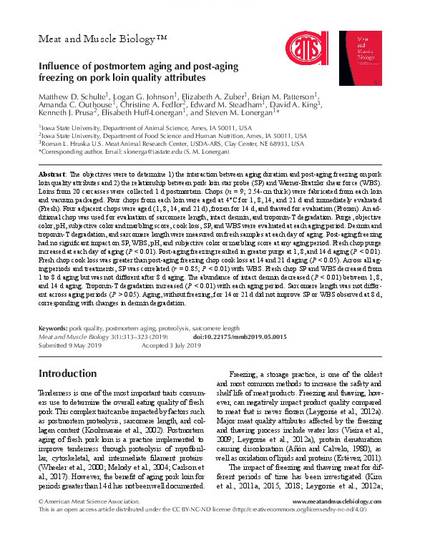
The objectives were to determine 1) the interaction between aging duration and post-aging freezing on pork loin quality attributes and 2) the relationship between pork loin star probe (SP) and Warner-Bratzler shear force (WBS). Loins from 20 carcasses were collected 1 d postmortem. Chops (n = 9; 2.54-cm thick) were fabricated from each loin and vacuum packaged. Four chops from each loin were aged at 4°C for 1, 8, 14, and 21 d and immediately evaluated (Fresh). Four adjacent chops were aged (1, 8, 14, and 21 d), frozen for 14 d, and thawed for evaluation (Frozen). An additional chop was used for evaluation of sarcomere length, intact desmin, and troponin-T degradation. Purge, objective color, pH, subjective color and marbling score, cook loss, SP, and WBS were evaluated at each aging period. Desmin and troponin-T degradation, and sarcomere length were measured on fresh samples at each day of aging. Post-aging freezing had no significant impact on SP, WBS, pH, and subjective color or marbling score at any aging period. Fresh chop purge increased at each day of aging (P < 0.01). Post-aging freezing resulted in greater purge at 1, 8, and 14 d aging (P < 0.01). Fresh chop cook loss was greater than post-aging freezing chop cook loss at 14 and 21 d aging (P < 0.05). Across all aging periods and treatments, SP was correlated (r = 0.85; P < 0.01) with WBS. Fresh chop SP and WBS decreased from 1 to 8 d aging but was not different after 8 d aging. The abundance of intact desmin decreased (P < 0.01) between 1, 8, and 14 d aging. Troponin-T degradation increased (P < 0.01) with each aging period. Sarcomere length was not different across aging periods (P > 0.05). Aging, without freezing, for 14 or 21 d did not improve SP or WBS observed at 8 d, corresponding with changes in desmin degradation.
Available at: http://works.bepress.com/elisabeth_huff-lonergan/135/

This article is published as Schulte, M.D., Johnson, L.G., Zuber, E.A. Patterson, B.M., Outhouse, A.C., Fedler, C.A., Steadham, E.M., King, D.A., Prusa, K.J., Huff-Lonergan, E., Lonergan, S.M. 2019. Influence of postmortem aging and post-aging freezing on pork loin quality attributes. Meat and Muscle Biology. 3:313-323. doi: 10.22175/mmb2019.05.0015.